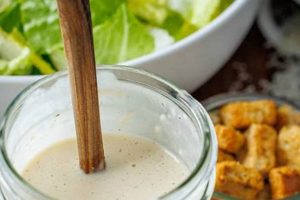A flavorful, complementary sauce enhances the somewhat bitter taste and robust texture of kale, transforming it into a palatable and enjoyable salad. This typically involves an emulsified mixture of oil, an acidic component like vinegar or citrus juice, and seasonings. For example, a lemon-tahini dressing provides a creamy, nutty counterpoint to kale’s earthiness, while a vinaigrette with Dijon mustard and maple syrup offers a sweet and tangy contrast.
The right sauce is crucial for making kale salad appealing. It not only improves the taste but also tenderizes the leaves, making them easier to chew. Historically, raw kale’s strong flavor often relegated it to a garnish. The development of flavorful complementary sauces elevated it to a salad staple, offering nutritional benefits with an enjoyable eating experience.
This article will explore various options, from classic vinaigrettes to creamy dressings, providing guidance on selecting the perfect complement to your kale salad based on personal preferences and dietary needs. Furthermore, the discussion will delve into the techniques and ingredients necessary for creating balanced and delicious dressings, ensuring a satisfying culinary experience.
Tips for Kale Salad Dressings
Creating a successful kale salad hinges on the dressing. These tips offer guidance for optimal flavor and texture.
Tip 1: Massage the Kale: After removing the ribs, massage the leaves with the dressing for 1-2 minutes. This softens the kale, reducing bitterness and improving texture.
Tip 2: Balance Flavors: A well-balanced dressing counteracts kale’s inherent bitterness. Acidity (vinegar, citrus) cuts through the richness, while sweetness (honey, maple syrup) adds depth.
Tip 3: Consider the Oil: Extra virgin olive oil offers a robust flavor, while avocado oil provides a neutral base. Nut oils, like walnut or hazelnut, add complexity.
Tip 4: Experiment with Acid: Lemon juice provides brightness, while red wine vinegar offers a sharper tang. Apple cider vinegar contributes a mellow sweetness.
Tip 5: Emulsify Properly: Whisk the dressing ingredients vigorously or use a blender to create a smooth emulsion that coats the leaves evenly.
Tip 6: Add Flavor Boosters: Enhance the dressing with ingredients like garlic, ginger, Dijon mustard, or nutritional yeast for added depth and complexity.
Tip 7: Season Carefully: Salt enhances the other flavors, but use it judiciously. Freshly ground black pepper adds a subtle bite.
Tip 8: Dress Just Before Serving: To prevent the salad from becoming soggy, add the dressing immediately before serving.
Employing these strategies ensures a delicious and satisfying kale salad experience. A carefully crafted dressing transforms kale into a culinary delight.
By understanding the interplay of flavors and textures, one can elevate a simple kale salad into a memorable dish.
1. Flavor Balance
Flavor balance is paramount in a successful kale salad dressing. Kale’s inherent bitterness necessitates careful consideration of complementary flavors within the dressing to create a palatable and enjoyable dish. A balanced dressing not only masks bitterness but also enhances the overall sensory experience.
- Acidity
Acidity, often from vinegar or citrus juice, plays a crucial role in cutting through kale’s robust, sometimes bitter flavor. Lemon juice provides brightness, while red wine vinegar offers a sharper tang. The level of acidity should be sufficient to counteract bitterness without overpowering other flavors. A squeeze of lemon juice in a simple olive oil dressing can transform a bitter kale salad into a refreshing experience.
- Sweetness
Sweetness balances acidity and further tempers bitterness. Honey, maple syrup, or even a touch of fruit juice can add depth and complexity. A maple-Dijon vinaigrette, for example, utilizes maple syrup’s sweetness to complement the sharp Dijon mustard and create a harmonious balance against the kale. The sweetness should complement, not dominate, the overall flavor profile.
- Fat
Fat, typically from oil, provides richness and mouthfeel. It coats the kale leaves, mellowing their texture and carrying the other flavors. Extra virgin olive oil offers a robust flavor, while avocado oil provides a neutral base. The choice of fat impacts the overall taste and texture of the salad. For example, a creamy avocado-based dressing offers a different sensory experience compared to a light vinaigrette.
- Saltiness
Salt enhances other flavors and helps to further balance bitterness. However, it should be used judiciously. A pinch of sea salt can elevate the other components of the dressing without making the salad overly salty. Proper seasoning allows other flavors to shine while contributing to overall palatability.
Careful consideration of these elementsacidity, sweetness, fat, and saltinessresults in a harmonious dressing that complements kale’s unique characteristics. Achieving this balance transforms a potentially bitter green into a delicious and satisfying culinary experience. The interplay of these elements within the dressing is key to creating a kale salad that is both nutritious and enjoyable.
2. Texture Enhancement
Texture enhancement plays a vital role in the enjoyment of kale salads. Kale’s raw leaves possess a naturally tough, fibrous texture, which can be unappealing to some. The dressing serves not only as a flavor vehicle but also as a critical component in modifying the kale’s texture, rendering it more palatable. The primary method for achieving this textural transformation is through the physical process of massaging the leaves with the dressing. This action helps to break down the tough cell walls of the kale, resulting in a softer, more tender leaf.
The effectiveness of texture enhancement depends on several factors related to the dressing. Dressings with higher fat content, such as those containing avocado or tahini, contribute to a creamier mouthfeel and further soften the kale. The acidic component of the dressing also plays a role. Acids like vinegar or citrus juice, in addition to balancing bitterness, help to tenderize the leaves. For instance, a lemon-tahini dressing not only provides a creamy, nutty flavor profile but also significantly softens the kale’s texture due to the combined action of the tahini’s fat and the lemon’s acidity. Similarly, a vinaigrette with a robust olive oil base will provide a softer, more palatable texture compared to a dressing with a lower oil content. The massaging process itself, combined with a well-formulated dressing, transforms the initially tough kale into a more delicate and enjoyable ingredient.
Understanding the relationship between dressing and texture enhancement is essential for creating a satisfying kale salad. The dressing’s composition, including the type and amount of fat and acid, directly impacts the final texture of the kale. Failure to adequately address texture through the dressing and massaging technique can result in a salad with an unpleasant, chewy consistency. Conversely, a thoughtfully prepared dressing, combined with the appropriate massaging technique, elevates the kale from a potentially tough green into a tender and flavorful salad component.
3. Ingredient Compatibility
Ingredient compatibility is essential when developing a dressing for kale salad. Careful selection ensures the dressing complements the kale’s flavor profile while contributing to a cohesive and balanced overall taste. Certain ingredients, due to their inherent properties, pair more effectively with kale than others. Consideration must be given to the interplay of flavors, textures, and even nutritional elements. For example, the robust, slightly bitter taste of kale pairs well with creamy, nutty dressings, such as those containing tahini or avocado. These ingredients offer a textural contrast and a complementary flavor that mitigates the kale’s bitterness. Conversely, a light vinaigrette with a delicate herb profile might become lost against the kale’s strong flavor, rendering the dressing ineffective.
Achieving optimal ingredient compatibility requires an understanding of how different components interact. Acidic elements, like lemon juice or vinegar, cut through kale’s bitterness, but excessive acidity can create an imbalance. Sweeteners, such as maple syrup or honey, add depth and complexity, but overuse can result in an overly sweet salad. Oils provide richness and mouthfeel, yet the choice of oil significantly influences the final flavor. A robust extra virgin olive oil offers a distinct taste, while a neutral avocado oil allows other ingredients to shine. Achieving a balanced and flavorful dressing involves selecting ingredients that complement each other and the kale itself, creating a synergistic whole. For example, a lemon-tahini dressing benefits from the interplay of lemon’s acidity, tahini’s creaminess, and a touch of garlic for complexity. Each ingredient contributes to a harmonious final product.
Understanding ingredient compatibility optimizes dressing development for kale salad. Careful selection and balanced incorporation of ingredients create a dressing that not only complements the kale but also elevates the overall culinary experience. Ignoring ingredient compatibility can lead to a disjointed and unsatisfying salad, where the dressing either clashes with the kale or fails to enhance its inherent qualities. Successful kale salad dressings rely on a thoughtful combination of compatible ingredients, where each element contributes to a harmonious and balanced final flavor profile.
4. Nutritional Value
Nutritional value represents a significant consideration when developing kale salad dressings. While kale itself offers a wealth of vitamins, minerals, and antioxidants, the dressing can either enhance or detract from the overall nutritional profile. A simple vinaigrette based on extra virgin olive oil contributes healthy fats and supports the absorption of fat-soluble vitamins present in the kale. However, dressings relying heavily on processed oils, excessive sugar, or artificial ingredients diminish the nutritional benefits of the salad. Furthermore, the addition of nutrient-rich components to the dressing, such as seeds (chia, flax, sunflower), nuts (walnuts, almonds), or nutritional yeast, amplifies the overall health benefits. For example, a tahini-based dressing provides calcium, iron, and healthy fats, complementing kale’s vitamin K and vitamin A content. The impact of dressing choices extends beyond flavor and should include a conscious effort to maximize nutritional intake.
Understanding the interplay between dressing ingredients and nutritional value allows for the creation of salads that contribute to a balanced and healthful diet. A dressing rich in omega-3 fatty acids from flaxseed oil, combined with antioxidant-rich berries in the salad, offers a powerful combination for promoting cellular health. Similarly, incorporating ingredients like garlic or ginger into the dressing not only enhances flavor but also introduces additional health-promoting compounds. Conversely, dressings laden with saturated or trans fats, excessive sodium, or added sugars negate the nutritional benefits of the kale and potentially contribute to adverse health outcomes. Therefore, informed choices regarding dressing composition are crucial for maximizing the nutritional value of the final dish.
Maximizing nutritional value through informed dressing choices represents a key aspect of preparing healthy kale salads. By selecting nutrient-rich oils, incorporating whole-food ingredients, and avoiding processed or nutritionally-deficient components, individuals can enhance the inherent health benefits of kale. This approach transforms the salad from a simple dish into a powerful tool for promoting overall well-being. Recognizing the direct impact of the dressing on the nutritional profile emphasizes the importance of strategic ingredient selection and mindful preparation in creating truly healthful meals.
5. Preparation Method
Preparation method significantly influences the final quality of kale salad dressings. Different techniques affect emulsification, flavor development, and texture. A whisked vinaigrette, for example, yields a light, airy dressing, whereas a blended dressing, incorporating ingredients like nuts or avocado, creates a creamy, emulsified texture. The order of ingredient addition also matters. Adding acidic components slowly to the oil while whisking promotes stable emulsification, preventing separation. Similarly, allowing certain ingredients to macerate before blending, such as garlic or shallots in vinegar, enhances their flavor contribution to the final dressing. Understanding these nuances ensures consistent, high-quality results.
Specific preparation methods offer distinct advantages depending on the desired dressing profile. For a creamy dressing, a high-speed blender emulsifies ingredients like tahini, yogurt, or avocado effectively, creating a smooth, cohesive texture. Conversely, a chunky dressing, perhaps incorporating chopped herbs, fruits, or vegetables, benefits from gentle hand-mixing to preserve the integrity of these additions. Furthermore, the preparation method influences the dressing’s ability to coat and adhere to the kale leaves. A well-emulsified dressing clings evenly, distributing flavor and contributing to a more satisfying sensory experience. Conversely, a poorly emulsified dressing separates, resulting in uneven flavor distribution and a less appealing texture.
Mastery of preparation techniques is essential for achieving desired flavor profiles and textures in kale salad dressings. Careful consideration of the interplay between ingredients and method ensures consistent, high-quality results. Improper emulsification, incorrect ingredient incorporation, or inadequate maceration can lead to a suboptimal dressing, negatively impacting the overall enjoyment of the salad. Employing the correct techniques for each specific dressing maximizes flavor development, texture enhancement, and ultimately, the culinary success of the final dish.
6. Storage Techniques
Storage techniques significantly impact the quality and longevity of kale salad dressings. Proper storage preserves flavor, texture, and nutritional value, while improper methods can lead to spoilage, oxidation, and undesirable changes in consistency. Understanding optimal storage practices ensures that dressings retain their desired characteristics and contribute positively to the overall salad experience.
- Dressing Storage
Dressings for kale salad, especially those containing fresh ingredients like herbs, fruits, or vegetables, are best stored separately from the kale itself. This prevents the leaves from becoming soggy and extends the shelf life of both components. Storing the dressing in an airtight container in the refrigerator maintains its quality and prevents contamination. Proper refrigeration slows down enzymatic activity and microbial growth, preserving the dressing’s flavor and texture.
- Ingredient Sensitivity
Certain dressing ingredients exhibit greater sensitivity to degradation than others. Dressings containing fresh herbs or avocado, for example, are more susceptible to oxidation and browning. Storing these dressings in airtight containers with minimal headspace reduces exposure to oxygen, minimizing these undesirable changes. Furthermore, adding a thin layer of oil on top of the dressing can create a barrier against oxidation, further preserving its quality.
- Temperature Considerations
Temperature fluctuations can negatively impact dressing quality. Repeatedly removing the dressing from the refrigerator and allowing it to sit at room temperature accelerates spoilage. Storing the dressing consistently at or below 40F (4C) inhibits microbial growth and maintains optimal quality. Avoid storing dressings near the refrigerator door, where temperature fluctuations are more common.
- Shelf Life Expectations
Realistically assessing shelf life expectations is crucial for food safety and quality. While properly stored dressings can last for several days, fresh ingredients inevitably degrade over time. Discarding dressings exhibiting signs of spoilage, such as off-odors, mold growth, or significant changes in texture or color, is essential. Generally, most homemade kale salad dressings are best consumed within 3-5 days of preparation.
By implementing appropriate storage techniques, individuals can maximize the shelf life and quality of their kale salad dressings. Proper storage preserves the carefully crafted balance of flavors, textures, and nutritional value, ensuring a consistently enjoyable and healthful salad experience. Neglecting these practices can compromise the dressing’s quality, potentially impacting the overall appeal and safety of the final dish. Understanding and applying these principles contribute significantly to the culinary success of kale salads.
Frequently Asked Questions
This section addresses common inquiries regarding the preparation and use of kale salad dressings.
Question 1: How can bitterness in kale be mitigated through the dressing?
Bitterness, a characteristic of kale, can be effectively managed through strategic dressing choices. Acidity from vinegar or citrus juice counteracts bitterness, while sweetness from honey or maple syrup provides balance. Massaging kale with the dressing further reduces bitterness by breaking down cell walls.
Question 2: What role does fat play in kale salad dressings?
Fat contributes richness, mouthfeel, and improved texture. It coats the leaves, mellowing their texture and carrying flavors. The type of fat influences the overall taste; extra virgin olive oil offers robust flavor, avocado oil a neutral base, and nut oils added complexity.
Question 3: How does one ensure a dressing adequately coats kale leaves?
Proper emulsification is key for even coating. Vigorous whisking or blending creates a stable emulsion that clings to the leaves, distributing flavor effectively. Massaging the kale with the dressing further enhances coating and tenderizes the leaves.
Question 4: Can nutritional value be enhanced through dressing choices?
Dressings can contribute significantly to nutritional value. Incorporating nutrient-rich ingredients like seeds, nuts, or nutritional yeast adds vitamins, minerals, and healthy fats. Choosing high-quality oils, like flaxseed or extra virgin olive oil, further enhances nutritional benefits.
Question 5: What storage practices maintain dressing quality?
Storing dressings separately from the kale prevents sogginess. Refrigeration in airtight containers maintains flavor and inhibits spoilage. Dressings with fresh ingredients, like herbs or avocado, benefit from minimal headspace and a layer of oil to prevent oxidation.
Question 6: How long can kale salad dressing be stored?
Properly stored dressings typically last 3-5 days in the refrigerator. Discard dressings exhibiting signs of spoilage, like off-odors, mold, or significant texture/color changes. Prioritize food safety and consume dressings within a reasonable timeframe.
Understanding these aspects ensures the creation of delicious and nutritious kale salads that maximize flavor, texture, and overall enjoyment.
Exploring various dressing recipes allows for customization and discovery of individual preferences, ultimately contributing to a more satisfying culinary experience.
Conclusion
Optimal kale salad preparation relies heavily on a carefully crafted dressing. This exploration has highlighted the crucial role dressings play in balancing kale’s inherent bitterness, enhancing its texture, and elevating its nutritional value. Key considerations include achieving flavor balance through acidity, sweetness, fat, and salt; employing appropriate preparation methods for emulsification and ingredient incorporation; and understanding ingredient compatibility for cohesive flavor profiles. Furthermore, proper storage techniques maintain dressing quality and maximize shelf life. Nutritional value can be significantly enhanced through the strategic inclusion of nutrient-rich ingredients in the dressing, transforming the salad into a powerhouse of beneficial nutrients.
Ultimately, a well-chosen dressing elevates kale salad from a simple dish to a culinary experience. Exploration of diverse flavor combinations and preparation techniques unlocks a world of possibilities, encouraging culinary creativity and promoting healthful eating habits. The transformative power of a thoughtfully crafted dressing underscores its essential role in maximizing the enjoyment and nutritional benefits of kale salad.






